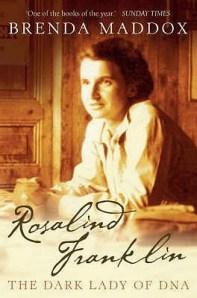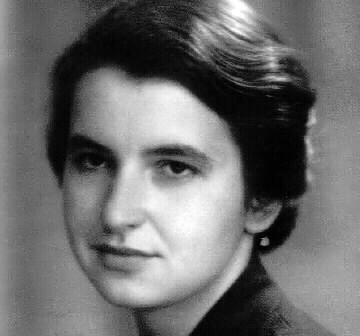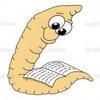
What’s it all about?:
Our dark lady is leaving us next week; on the 7th of March, 1953 Maurice Wilkins of King’s College, London, wrote to Francis Crick at the Cavendish laboratories in Cambridge to say that as soon as his obstructive female colleague was gone from King’s, he, Crick, and James Watson, a young American working with Crick, could go full speed ahead with solving the structure of the DNA molecule that lies in every gene. Not long after, the pair announced to the world that they had discovered the secret of life. But could Crick and Watson have done it without the dark lady? In two years at King’s, Rosalind Franklin had made major contributions to the understanding of DNA. She established its existence in two forms and she worked out the position of the phosphorous atoms in its backbone. Most crucially, using X-ray techniques that may have contributed significantly to her later death from cancer at the tragically young age of 37, she had taken beautiful photographs of the patterns of DNA.
What did I think?:
Rosalind Franklin is unfortunately probably best known for not achieving the recognition she should have got in life for unravelling the secrets of DNA. Instead, two scientists called Francis Crick and James Watson boldly used parts of her work to find out the secrets for themselves and published their findings which led to them winning the Nobel Prize. Personally, I was aware of the dis-service that had been done to Franklin but did not realize until reading this book exactly how much her work had contributed to the unveiling of “the molecule of life.” The book tends not to focus too much on the early part of Rosalind’s life as it is when she becomes a scientist, the true nature of this independent, determined and highly intelligent woman is realised. However, a couple of things sprang to my attention from her early life. Firstly, a letter written by one of her relations describes the young Rosalind as:
“alarmingly clever – she spends all her time doing arithmetic for pleasure & invariably gets her sums right.”
Although the word “alarmingly” is probably meant as an endearment it resonates from a time when females were not expected to be clever as managing their household and pleasing their husbands was probably the best they could amount to. It is no wonder that Rosalind has become somewhat of a feminist icon. After all, being Jewish, female and a scientist in times which were not friendly to all three is a tremendous achievement. Being a bit radical also ran in her family as her Uncle Hugh, a pro-suffragist, attempted to attack Winston Churchill with a dog whip due to his opposition to women’s suffrage. Rosalind knew herself from the age of twelve that she wanted to become a scientist and certainly fit the criteria according to Einstein:
“a scientist makes science the pivot of his emotional life, in order to find in this way the peace and security which he cannot find in the narrow whirlpool of personal experience.”

Rosalind Franklin (picture from mysciencebox.org)
She first began to make a difference during the war where she was employed by the British Coal Utilisation Research Association studying the porous nature of coal and the density of helium. Her work there led to coals being classified, predicting their potential for fuel and for the production of essential devices i.e. gas masks. In 1946, she extended her CV and broadened her skills by studying X-ray diffraction with the French scientist Jacques Mering, a technique that would prove crucial and valuable in her later work with DNA. It was during her next post with Kings College that she finally made her mark, discovering that there were two forms of DNA and that they were helical in structure. Indeed, her X ray photographs of the molecule were pronounced by J.D. Bernal to be amongst the most beautiful X ray photographs of any substance ever taken.
Enter Watson and Crick, who were currently working on producing a model of the structure of DNA but were having a few technical problems with discovering exactly where each bit went. Papers and photographs belonging to Franklin were given to Crick on the sly causing them to pronounce that they had discovered “the secret of life.” Shockingly, they then went on to publish their paper in the journal Nature in the spring of 1953 with only a short footnote regarding the “general knowledge” of Franklin’s contribution. Franklin’s paper did follow but due to the order of publishing, it seemed only support for Watson and Crick’s amazing discovery, rather than revealing who exactly had done all the legwork. Unpublished drafts of her papers revealed that it was she alone who had discovered the overall form of the molecule with the location of the phosphate groups on the outside. Rosalind went on to carry out brilliant work on the tobacco mosaic and polio virus but tragically succumbed to ovarian cancer in 1958 at just 37 years of age.
I found this book to be an absolutely fascinating read even if I did get carried away a bit at times with the injustice done to Rosalind Franklin and the tragic end to her life. She wasn’t particularly careful when using radiation and tended to just “get on with it,” neglecting to wear appropriate protective coverings or adhere to our now stringent safety requirements when dealing with such a hazardous substance. Could this have contributed to the development of her cancer? She was also a very interesting person, perhaps a bit prickly at first and difficult to get to know but she was immensely passionate about many things besides her beloved science – for example, traveling and climbing and was a fiercely loyal friend. For me, it was wonderful to read an interesting account of a woman that made such a difference even if it was sadly not recognised in her own lifetime.
Would I recommend it?
But of course!
Star rating (out of 5):


